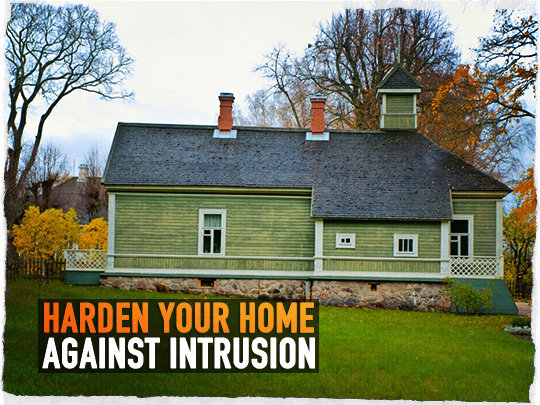
Typically, most home doors open in. The door is attached to a frame using hinges that hold the door in places with pins. The advantages to this type of door is cost, ease of installation and the hinges are on the inside making it impossible to remove the hinge pins from the outside, and thus removing the door.
Disadvantages include the fact that the door can be kicked by intruders or blown in by heavy winds. The framing is usually builder grade lumber and the bolts are standard security measures that can be manipulated or forced to fail with little effort.
Commercial structures however, have doors that usually open out, and the main reason for this is safety. If there is a fire in the building or other emergency and people are crowded at the door, it may be impossible to open the door in, but pushing the door out can be accomplished even if you are squeezed up to the door by people behind you. Slap bars on emergency exits make it even easier to open if there is an emergency.
The government in its infinite wisdom rates barricades such as doors, fences and other barriers by how long it takes an “unauthorized” person to make entry by use of force. The longer the barricade, lock, door or safe holds up under a battering, the higher the rating, and a higher rating is better of course.
Just because you harden your doors, windows and home in general does not mean it is impossible for someone to make illegal entry however. The objective when deciding on security is determining whether the methods in place or ones you intend to put in place would hold up long enough for you either to escape, or to launch a counter offensive. Simply put most security protocols in place simply discourage, slow down or inconvenience a determined intruder.
Reversing Your Doors
In hurricane country sometimes the doors to residential homes are mounted so the doors open out. This of course makes it harder for a strong gale wind to push the door in. These types of doors are expensive to install, because a frame must be built to protect the hinges. For optimum security, the framing would be steel to protect the hinges from breaching. Pneumatic battering rams are used by law enforcement and the military to breach hardened doors like this but it is not likely your typical looter or burglar would be carrying one around.
The recess where the dead bolt rests would also be framed in steel instead of the typical wooden frame. The wooden recess that houses the deadbolt on most homes would give away rather quickly under impact allowing the door to swing in.
A door with shielded hinges makes it difficult to do a ballistic breach using a shotgun or some other type of firearm. The metal frame could of course be destroyed to gain access to the hinges but this goes back to, giving you the time to evaluate your next move. It would take time to breach a door hardened in this manner, thus giving you time to escape or set up a defense.
Windows
Hurricane shutters are not just for hurricanes. Metal security bars are popular as well, but objects can still be propelled through the grates breaching the glass. Hurricane shutters on the other hand, are designed to keep flying debris from smashing through the glass openings in your home. In the case of a SHTF situation having hurricane shutters may prevent vandalism of your glass and to keep someone from tossing a stun grenade, smoke grenade or tear gas canister through your glass openings.
Plywood would work just as well if mounted on the outside of your windows, but the sheets cannot be easily removed during the day if needed, whereas shutters can be opened and closed as you see fit. Standard window shutters that actually function by opening, closing and latching would be better than not having any protection at all for your windows.
Outside The Home
Barricades such as steel or wood fencing or even block walls are a deterrent, but like any barricade, they can be breached. The best barricade is one that is monitored. Barricades slow an intruder down allowing security personnel, or in this case you to get into a defensive posture. Fences in and of themselves only act to discourage intrusion unless they are high enough and slant out with barbed wire rolled along the top and even with all this, they are not impenetrable.
Clear Fields of Fire Are Important
If you wanted or needed to militarize your home or compound, you would need to deny intruders cover from direct or indirect fire from the compound or home. This means all hiding places would have to be eliminated. Cover would include trees, outbuildings, large rocks and vegetation that would provide cover. Any outbuildings would have to be positioned so that a shooter inside would not have a line of sight to the main house. This would take considerable effort, and in most cases not worth the effort. However, you do need to mark and monitor all hiding places.
Consider a surveillance camera system to monitor possible hiding positions along the perimeter. The system would be monitored in real time once there is an intrusion so everyone can be made aware and updated as to the positions of the intruders.